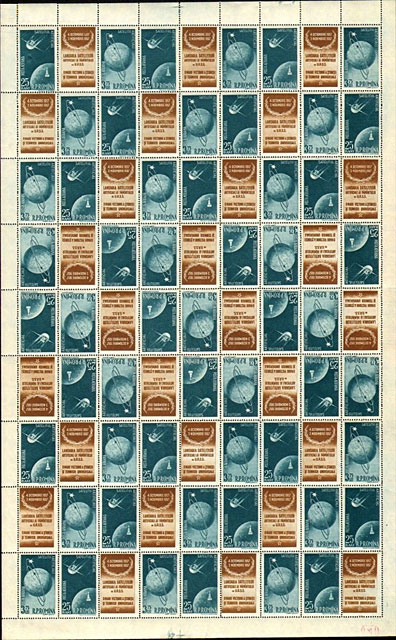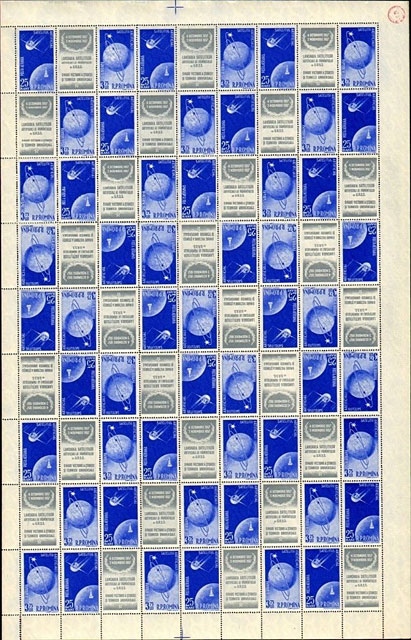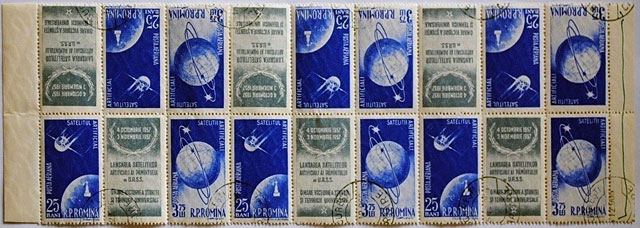THE FIRST TWO ARTIFICIAL SATELLITES OF THE EARTH
ON THE ROMANIAN POSTAL STAMPS
Victor Manta, PWO
Introduction
In my youth, when living in Romania, I became a passionate collector of the very popular theme "The Conquest of the Space." The regretful reason why I gave up the collecting of this topic is presented on the page " MY FRUSTRATING ROMANIAN SOUVENIR SHEETS ”. Link.
In line with the above, while preparing an article about the very interesting issue of the Romanian Post dedicated to the 1958 Universal Exhibition in Brussels, I had to study more deeply the Romanian 1957 Artificial Earth Satellites issue, which is the physical support of the first, to understand how was "built" this issue. The surprises appeared very fast, with which the philately of the communist times does not stop to “gratifying” us. This way the introduction that I initially planned as being short was gradually transformed into a self-contained article.
The launch of Sputnik I + II and the related Soviet Union philatelic issues
The first Earth Artificial Satellite was launched by the USSR on October 4, 1957. It was celebrated by the country that launched it with a stamp issued on November 5, 1957 (that is, after a month), by an ordinary print run for a such a country, one of 3 million copies (Michel catalogue, No. 2017).
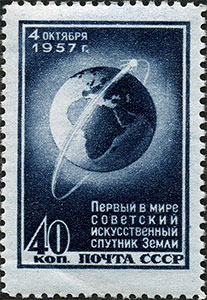
The Soviet post office, in the light of its financial interests, did not forget the stamp collectors, by “landing" on November 28, 1957 an overprint over an existing stamp, which was dedicated to the Russian scholar Tsiolkovsky, Michel No. 2026. The print run of the overprinted stamps was of only 115,000 pieces. As expected, the current catalog prices reflect this reduced quantity. The original not overprinted stamp was issued on October 7, 1957, having a usual print run of 2 million copies.
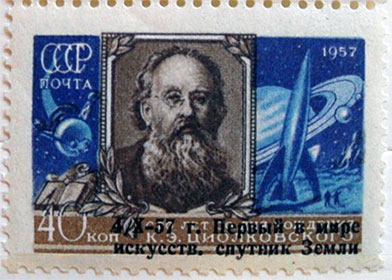
The USSR launched Sputnik I's successor, Sputnik II, after a month, more precisely on November 3, 1957. Inside it, there was a dog named Laika, whose tragic disappearance was particularly disturbing to the children of the time. Honoring the Sputnik II, the Soviet post launched a set of stamps on December 30, 1957 (again after about a month), Mi No. 2041 A - 2045 A, two million issued, excepting for 2044 A, with a circulation of 5 million. Below I show one of these stamps.
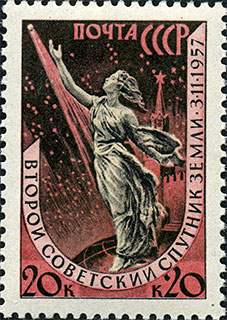
We see from these dates that the Soviet post office needed about four weeks between the production of the event and the issuing of the material related to the respective philatelic products.
The ROMANIAN Sputnik I and II Stamps
The geopolitical context
Let us move on to what we are more interested in, that is, to the Romanian stamp issue dedicated to the same events. Let us remember that Romania was a country occupied by Soviet troops between 1944 and 1958, and that Romania was for long years afterwards under the Soviet rule, which explains what follows. Source
Note: To those who still prefer the term "Liberation of Romania by the glorious Soviet Army" may I recommend the "Davai Watch" page on my website "Communism on postage stamps".
The "Earth' Artificial Satellites" and "Laika"
As a good and faithful ally, and as a "longtime friend” of the Soviet Union (a country that, as it was said, bordered with whom it wanted), Romania hastened to commemorate, in a single blow, the launching of the two Soviet satellites. It happened on November 6, 1957, by launching the stamp issue "Artificial Earth' satellites", consisting of two triptics, with a total nominal value of 8 lei, very high for that time. The total print run was of one million triptics, a large figure, but not unusual for that time. Mi. 1677 - 1680, Scott C49 - C52.
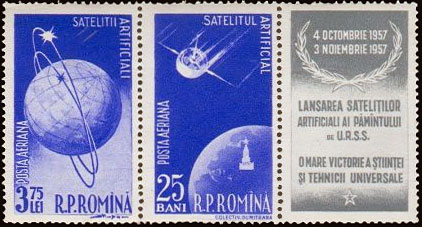
The reason why Romania commemorated successes of a different nation is clearly explained by the Communist propagandists on the label of the issue: "A Great Victory of Universal Science and Technique." As known, it was a success of just two countries, one being the USSR, and the other one the earlier defeated Nazi Germany, whose advanced rocket industry was dismantled after the Second World War and then reassembled in the USSR by German specialists who were "convinced" to work in the USSR for the war winner. This also explains why the Soviet total supremacy in the exploration of space was rather short-lived.
As it was to be expected from a faithful ally, the issue dedicated to Sputnik II and Laika, the martyr dog, was commemorated by a series of two values issued by the Romanian Post on December 10, 1957, Mi. 1684 -1685. The print run was of 2 million copies for aesthetically a very appreciated set and one that was largely used for postage, which is why even people from my non-philatelic generation remember them with some nostalgia.
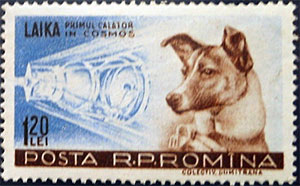 |
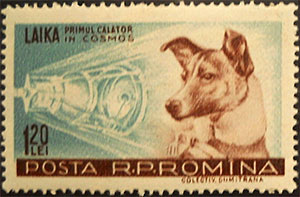 |
After these explanations let me ask, with a good dose of skepticism, how it was possible that the Romanian triptic series were issued on 6 November 1957, when the Sputnik II satellite was launched on November 3 of the same year, as it is written on the label? That is, it took the Soviets almost a month to issue a stamp, but the Romanian PA achieved the same thing in just two days, a set consisting of a complicated printed issue, and not one quickly overprinted and thrown on the market?
Since both international catalogs, Scott and Michel, give the same issue date, that of November 6 (which is not just a day among others, but the eve of the so-called Great Socialist October Revolution, the great communist feast!), I can only make some plausible assumptions. The idea that the Soviets would have told their comrades in Romania when the Sputnik II will be launched can be dismissed as absurd, this being one of the best kept secrets to hide possible failures. What I can imagine is that either the triptics appeared later, being only reported to have appeared at the time that was announced, or they were produced just in two madly working days and nights. It seems to me as unlikely to design and then print this technically complicated issue so fast. Anyway, we have here, as it is written on the label, "A Great Victory of Universal Science and Technique" ...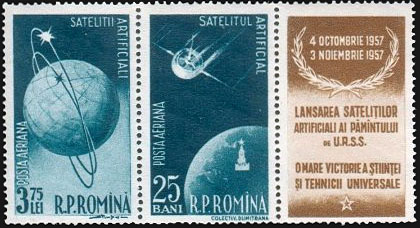
Please see below two memorable pieces of my modest philatelic collection of Romanian postage stamps, namely an envelope franked with the two above mentioned triptics, which I cancelled on April 12, 1961, the day when the first cosmonaut, Yuri Gagarin, flied to space. The canceling devices imprints, kindly applied by an office worker from the Bucharest Post Office 30 (Glinka Street, Floreasca), appear as pale due to the advanced wear of canceling devices, even if the lady at the counter tried to clean them before applying them on my precious covers. Of course, everything is just a philatelic fabrication, which reflected my philatelic level at that time, at the age of 16, but the idea was so exciting! As memories of my youth, they remain for me anyway invaluable. I note that then (after four years after being issued) those stamps were still sold at their facial value by the stately owned philatelic trade, that is why I used pieces from my own collection, which I could later replace at the same price.
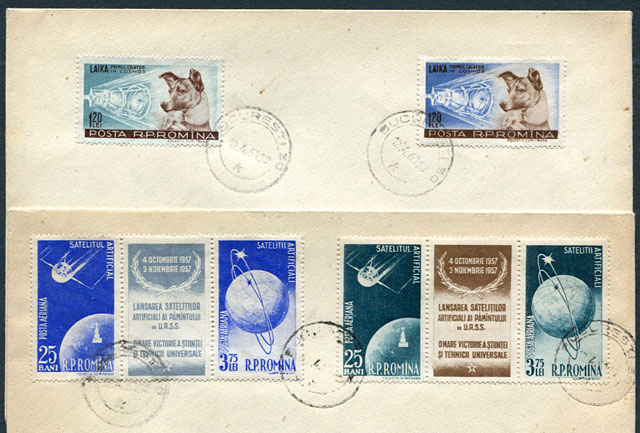
The mapping of triptics
I have compiled, based on some data taken from the Michel catalogue, a table showing the positioning of the various triptics, straight and reversed, to which I have attached a mean of identifying the positions by using the chess notation. I marked by different background colors the central rectangle (A4 - A6 - I6 - I4) that contains the reversed triptics (one color by triptic).
A |
B |
C |
D |
E |
F |
G |
H |
I |
|
1 |
.25-T-3.75 |
.25-T-3.75 |
.25-T-3.75 |
.25-T-3.75 |
.25-T-3.75 |
.25-T-3.75 |
.25-T-3.75 |
.25-T-3.75 |
.25-T-3.75 |
2 |
T-3.75-.25 |
T-3.75-.25 |
T-3.75-.25 |
T-3.75-.25 |
T-3.75-.25 |
T-3.75-.25 |
T-3.75-.25 |
T-3.75-.25 |
T-3.75-.25 |
3 |
3.75-.25-T |
3.75-.25-T |
3.75-.25-T |
3.75-.25-T |
3.75-.25-T |
3.75-.25-T |
3.75-.25-T |
3.75-.25-T |
3.75-.25-T |
4 |
3.75-T-.25 |
3.75-T-.25 |
3.75-T-.25 |
3.75-T-.25 |
3.75-T-.25 |
3.75-T-.25 |
3.75-T-.25 |
3.75-T-.25 |
3.75-T-.25 |
5 |
.25-3.75-T |
.25-3.75-T |
.25-3.75-T |
.25-3.75-T |
.25-3.75-T |
.25-3.75-T |
.25-3.75-T |
.25-3.75-T |
.25-3.75-T |
6 |
T-.25-3.75 |
T-.25-3.75 |
T-.25-3.75 |
T-.25-3.75 |
T-.25-3.75 |
T-.25-3.75 |
T-.25-3.75 |
T-.25-3.75 |
T-.25-3.75 |
7
|
.25-T-3.75 |
.25-T-3.75 |
.25-T-3.75 |
.25-T-3.75 |
.25-T-3.75 |
.25-T-3.75 |
.25-T-3.75 |
.25-T-3.75 |
.25-T-3.75 |
8 |
T-3.75-.25 |
T-3.75-.25 |
T-3.75-.25 |
T-3.75-.25 |
T-3.75-.25 |
T-3.75-.25 |
T-3.75-.25 |
T-3.75-.25 |
T-3.75-.25 |
9 |
3.75-.25-T |
3.75-.25-T |
3.75-.25-T |
3.75-.25-T |
3.75-.25-T |
3.75-.25-T |
3.75-.25-T |
3.75-.25-T |
3.75-.25-T |
A |
B |
C |
D |
E |
F |
G |
H |
I |
To clarify this table, I also present below the images of two full sheets, images that you can enlarge by clicking on them. They could serve you later to follow what I wrote in the following article about the same triptics, that were overprinted for the Brussels Exhibition issue of 1958. Link.
Please note how much differ the selvages of the two sheets, in width and as perforations, which asks for increased attention when trying to find the positions on the sheet of any given triptic.
I conclude by showing to those interested a complete central tête-bêche like, cancelled to order (CTO), which I would place, by using my notation, on the lines 6 and 7, even if the perforations of the selvages do not fit to those of the full sheet. The philatelists of the period noticed the significant number of varieties that could be extracted from the full printed sheets, such as triptics with the labels placed in three different positions, and, more interestingly, even pairs of vertical tête-bêche units, whose number is small when considering the total number of triptics. Let us also consider the fact that a large quantity of stamps of this issue has been cancelled to order and / or used, commendable, for postal purposes, which reduced the full triptics quantities available today to collectors.
We notice that the selvages appear in the above pictures without color strips. However, there are many cases of selvages with full colors covering the long sides of the sheets. An article published (in Romanian) suggests that different cylinders were used, which were replaced as the old ones became useless due to wearing. This seems plausible, considering that one million copies of this issue have been printed.
Watermarks
The Michel 2014 online catalog mentions the use of a paper with a unique watermark, identified as # 10. The Scott 2013 catalogue does not mention any watermark, although the stamps issued before and after this issue are referred as being watermarked. Unlike these modern catalogues, the Romanian Postage Stamps Catalogue of 1974 correctly mentions two types of watermarks, shown in the below images.
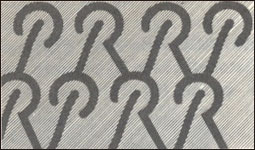 |
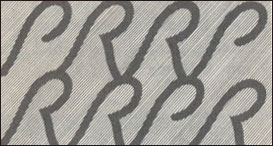 |
Watermark no. XVII |
Watermark no. XVIII |
Both watermarks, which appeared in 1957, have also other common features, such as their darker color than that of the paper, the interconnected letters, the diagonal directions of the letters, the height of 13 mm and their appearance in 8 positions.
The well-known philatelic blogger Mr. Cornelius Ionescu is the one who sent me the pictures of these watermarks and signaled the effective use of both of them on the triptics, he holds in his personal collection. Below you can see an example of using of the watermark No. XVII. Another example, that of using the watermark No. XVIII appears on my page about the Artificial Earth' Satellites that were overprinted for the 1958 Brussels exhibition.
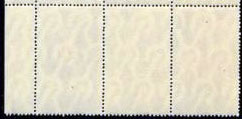
Essays
I also owe to Mr. C. Ionescu the images of the color essays reproduced below.
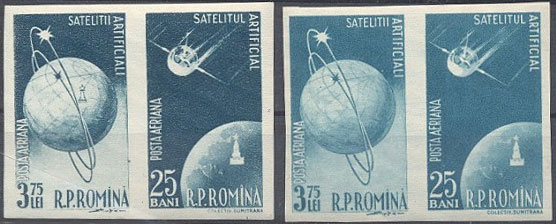
They appeared on the market after 1990, with no vignettes, being probably well hidden until then. I consider again that the two theoretical days that were available to design and issue the triptics couldn't be enough even for making color essays and choosing among them...
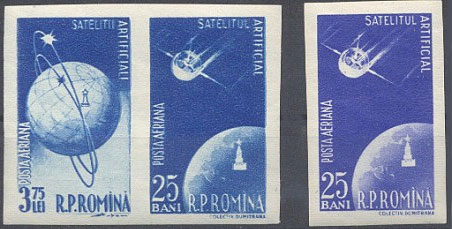
In a subsequent article I cover, as I have already written, the overprinted version dedicated to commemoration of the 1958 Universal Exhibition in Brussels.
USA, Switzerland, April 2014 - May 2019
Addendum
This article has also appeared in the No. 6 (35) - November-December 2014 of the Romanian printed magazine philatelica.ro . I was pleased to learn that Mr. Dan Dobrescu, the editor and founder of the magazine, published on page 47 of the same issue "Remarks on the Launch of Artificial Earth Satellites issue.” He found “(…) some documents from the archive of the former National Philatelic Museum and he presented the “Good for the print” sheets, stating that the approval was given on November 5, 1957. We reproduce below the images of the two sheets, published by Mr. Dobrescu in his magazine.

I also learned from Mr. Dobrescu that the designer of the 3.75 lei stamp was Dimitrie Ştiubei, a name that it is impossible to decipher on the respective stamp, as opposed to "Dumitrana's Collective", which is extremely visible on the 0.25 lei stamp.
Unfortunately, these clarifications do not elucidate the mysteries of the issue date for this set. Since the second artificial earth satellite was launched on November 3, 1957, a date mentioned also on the label, I do not see how it was possible that the “ready for print” had been given already on November 5, 1957, that is, only two days after the launch of the satellite itself. Let us remember again that this is a technically complicated stamp issue with three rotated rows on the sheet. We also know that some color tests have been made beforehand, which were also presented in this article. The making the color models and the decision taking process that followed has, of course, required some time.
It is also intriguing that the known designers' team (Dumitrana) was not requested to make the design of both stamps, the call for the second stamp being addressed to another designer (Dimitrie Ştiubei).
All this leads me to the idea that we are in the face of a manipulation resulting from the political decision to issue the stamps on the anniversary day of the 40 years of the so-called Great Socialist Revolution of October. My working hypothesis is that it was initially planned to celebrate on stamps the launch of Sputnik I, which is why the text "Artificial Satellite" appears on the value of 0.25 lei, the one designed by the Dumitrana team. The date of issue was set to be fatidicNovember 6, 1957, and the work for that begun. It is not impossible that the predefined format was the same as the final one but using another image (showing Lenin, or a red flag?) for the stamp of 3.75 lei and with another text on the label.
The launching of Sputnik II three days prior to the launch of the hypothetical Romanian Sputnik I stamp totally changed the planning. When the changes and additions were communicated to him, the designer D. Ştiubei (being freer at that time?) was assigned to the task to redesign the stamp valued 3.75 lei. He has done what it was possible and someday (when?) the set was put on the market. Under these circumstances, the "Good for print - imprimatur" on the presented sheets could only be one that was predated, a relatively minor lie when compared to so many others, much worse, from that history of the occupied Romania.